Out-of-the-Box Thinking Needed to Safeguard the Community Against Coronavirus
- Details
- Written by: Joanne Wallenstein
- Hits: 4411
 (This is the opinion of site founder Joanne Wallenstein) We’re living in unprecedented times. Each day the news appears more like a doomsday script for a movie I would be too frightened to watch. On the national level, our President is unhinged, he’s dismissed and ignored the experts and mocked science saying anything that doesn’t fit into his playbook is “fake news.”
(This is the opinion of site founder Joanne Wallenstein) We’re living in unprecedented times. Each day the news appears more like a doomsday script for a movie I would be too frightened to watch. On the national level, our President is unhinged, he’s dismissed and ignored the experts and mocked science saying anything that doesn’t fit into his playbook is “fake news.”
Up to a month ago, policy on the national level was disheartening, hurt our sensibilities and our pocketbooks but did not threaten our very survival. Now with the outbreak of the highly communicable and possibly fatal COVID-19 or Coronavirus, failures at the national level could have dire consequences on the local level.
We’ve already seen the President contradict the scientists and deny the severity of the threat. We’ve read news reports from those who feared they had the Coronavirus but were unable to get tested as they didn’t meet CDC guidelines – only to later learn that they were infected. Anyone who can read has good reason to be skeptical about the way that our national leaders are handling the outbreak.
So now more than ever, it’s important that we think smart on a local level and call on our Scarsdale leadership and resident experts to safeguard our community. We have a Mayor, Village Manager, Village Board, School Superintendent and School Board who can all make critical decisions in these unusual times.
One of the goals of our school curriculum is to teach critical thinking skills, and now’s the time for these local leaders and our uniquely-qualified residents to analyze the situation, formulate plans and implement them if needed.
Last week Scarsdale faced its first challenge in the crisis when families returned home from the February break. It quickly became known that several families travelled to Milan and skied in Northern Italy where there has been an outbreak of the virus. Another family travelled to South Korea, an area hit hard by the virus.
The CDC recommended that those who spent time in either country in the past 14 days take precautions. Many companies who have employees who travelled to affected regions are requiring them to self quarantine for 14 days before returning to work, even if they are showing no symptoms of the disease, which can take weeks to manifest.
However, our school district has not required students who travelled to Italy or Korea to abstain from attending school. Naturally, parents with children in the classrooms with these returning travelers are concerned. Though the travelers might feel fine now, they may have been exposed and could potentially become ill during the next few weeks and infect others. It is unknown if the disease can be spread before people become symptomatic, but it appears that it might.
Parents questioned the school district and requested that the families who travelled should be encouraged to self-quarantine for the recommended two-week period. Even if it turns out that no one was exposed or infected, this would safeguard the rest of the children -- and the community at large.
The school responded by saying, “School attendance is compulsory under the law,” and said they had no right to “question or monitor where District families travel,” and “do not have the right to impose additional quarantines above the procedures set out by the government.”
Furthermore, “The District has a responsibility to work with the County Department of Health for students exhibiting symptoms and have traveled to China under Education Law 906.1 (This law is explained well in the State Guidance I have linked in the District-wide emails). District nurses have been instructed to seek guidance from the county in any situation when a symptomatic child has traveled to an affected region as the law currently only covers China.”
The school did not change their response when more countries were added to the list. This weekend several airlines suspended flights to Northern Italy, recognizing the difficulty of containing communication of the virus.
According to the district policy, the school nurse is bound to wait for a child to exhibit symptoms before making any recommendations regarding attendance. But as other parents have pointed out, once the child develops symptoms, it’s simply too late to protect others in the school.
The district did agree to reach out to families if they were made aware of travel to affected countries, saying “In instances where the District has information about student or family travel to an affected region, we are reaching out to those families to support them and make sure they are aware of the CDC recommendations.”
This offered little solace to parents who had no way of knowing whether the affected children would be present at school.
We spoke with one very worried mother who contacted Superintendent Thomas Hagerman, Director of Special Education and Student Services Eric Rauschenbach, her school principal and the class teacher to ask if the children who travelled could stay home for two weeks, as recommended by the CDC. All gave her the same response: “There’s nothing we can do.”
Another parent told us that one of the families offered to quarantine themselves for two weeks and were told, “You and your family have done nothing wrong and deserve to return to your normal routine without this type of interruption.”
Where does this leave the balance of the community? What about the rights of others to attend school, free from fear? It seems the only choice for those who are worried is to pull their own children out of school.
This problem is an easy one to solve. Administrators could actively encourage these families to keep their children home rather than run the risk of infecting their classmates. Since there are only a handful of families involved, only a few would be inconvenienced to spare many from potentially catastrophic results.
In this case, instead of doing some out of the box thinking, district administrators appear to have contacted their lawyers and come up with a policy that could work for another type of virus, but not for this one.
As my 84 year-old aunt said, “I have never lived through a pandemic,” and neither have any of us. In order to minimize the risk to everyone in the community, let’s ask our leaders to be flexible and creative and use their critical thinking skills to balance the rights of a few vs. the needs of the community.
Vicki Presser Presses On
- Details
- Written by: Joanne Wallenstein
- Hits: 3144
 Vicki Presser, the Public Information Officer, media liaison and the voice of the Scarsdale School District has announced she will retire in June after 18 years on the job.
Vicki Presser, the Public Information Officer, media liaison and the voice of the Scarsdale School District has announced she will retire in June after 18 years on the job.
We asked Presser a few questions about her role, her history and the future and here is what she shared”
What are your current responsibilities?
I write or edit all the articles in Insight, and take the classroom photos that are published there; I gather and edit the articles for 'Dale Dispatch; I send Board meeting notices and news releases out to the news media and the community, and write and distribute Board Highlights; I edit reports and papers written by our District administrators; I write special pieces as needed; I answer community and reporter requests for information; I post items on the District Facebook page and contribute to Website postings; I notify news media concerning inclement weather postings; I take part in Safety, Security, and Emergency Management committee work; and there's probably more things that are not coming to mind just now! Oh right: I help bewildered, lost people in the hallway -- a lot. That just happened, so it reminded me.
How has the job changed during your tenure?
Google Docs is a game-changer, as they say. So much easier to collaborate on drafts and keep track of changes.
Under which superintendents did you serve and how did their communication styles vary?
Just Dr. McGill and Dr. Hagerman.
How has the advent of social media affected the way you communicate with the community?
In 2002 Facebook was barely a thing. Now we have nearly instantaneous access to information. But the same rules of communication apply - be clear, concise, and mindful of community concerns.
Were you ever fooled into reporting a fake story or fake news?
Nope. I'm the one telling people to go to Snopes and check the veracity of a story BEFORE passing it around.
What was one of the funniest stories you ever reported?
Not exactly that, but here's one of my favorite stories: It was Human Rights Day at the Middle School some years ago. I had twisted my ankle badly the day before, but gamely limped around the hallways taking photos -- until principal Mike McDermott stopped me and said, "young lady, I'm sending you to the nurse's office!" Now, that is truly one of the perks of working in a school district.
Down the road, what changes in district communications do you anticipate?
I've already seen the transition from phone calls to emails to texts. But some things never change -- for example, a print newsletter is still the only reliable way to reach everyone living in the community.
Do you think the job description for your replacement will differ from what you currently do?
I'm certain my successor will find new and better ways to get the work done -- and will probably also be able to reach items on top shelves.
What do you plan to do in your retirement?
I was recently elected to the White Plains Common Council, and very much enjoy serving the community where I've lived for nearly 40 years. But another title I got in January is even more exciting -- Grandma! My new granddaughter is in Chicago; regular visits will be in order. Apart from that, I'll be glad to have more time to read, take part in synagogue activities, attend concerts, and visit museums and parks.
From the School Board: Deconstructing the 2020-21 School Budget, Renovations to SHS Auditorium and Mold at the Middle School
- Details
- Written by: Joanne Wallenstein
- Hits: 3916
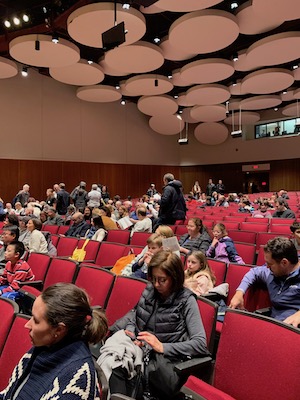 As a result of projected energy savings, school administrators were able to decrease the projected tax levy increase for 2020-21 to 3.31%, translating to a 3.15% tax increase for Scarsdale residents and a 3.98% increase for residents of the Mamaroneck strip. The total budget is now projected to be $166,875,850. The numbers were reviewed at a budget study session of the Scarsdale Board of. Education on Monday night February 10, 2020.
As a result of projected energy savings, school administrators were able to decrease the projected tax levy increase for 2020-21 to 3.31%, translating to a 3.15% tax increase for Scarsdale residents and a 3.98% increase for residents of the Mamaroneck strip. The total budget is now projected to be $166,875,850. The numbers were reviewed at a budget study session of the Scarsdale Board of. Education on Monday night February 10, 2020.
At the meeting, administrators reviewed key elements of the school budget, highlighting priorities and changes to the budget.
Here are a few highlights from each of the presentations:
Assistant Superintendent for Curriculum Edgar McIntosh reviewed the largest single component of the budget; $60,334,389 in salaries for instructional staff that includes professional development supplies and instructional materials.
According to McIntosh, the guiding principle behind the educational program are:
Students are at the Center
It is important to connect knowing and doing
Creation and cohesion require collaboration
Scarsdale is a destination (but not an island)
Mcintosh explained that the program and curriculum are assessed and reviewed on an ongoing basis. The staff uses the summer to look at the curriculum, assess and adapt what they are teaching.
Another component of the program is arts education. The district has an Alvin Ailey dance program in the school, has relationships with external art institutions and invites visiting artists and arts programs to come to the district.
The district conducts several programs to connect our students and educators with those from other countries. The district runs the Interdependence Institute and this year will host international leaders during the Global Alliance in April.
For faculty, the district runs the Scarsdale Teacher’s Institute for professional enrichment and growth and also offers teachers grants for professional development through the Center for Innovation.
As a part of Scarsdale’s commitment to sustainability, the schools run a gardening program at all district schools where students learn to grow their own food and conduct plant-based research. At the high school, there is an advanced science research program as well as AT courses that are now being assessed and reviewed.
Special Education
Director of Special Education Eric Rauschenbach explained the 9.35% growth in his portion of the budget for 2020-21.
The proposed special education budget is $15,616,807, up $1,334,972 from 2019-20 or 9.35%. In the last ten years, the district has seen an increase in the number of classified students, going from 6.8% of the school population in 2010 to 10.4% in 2020. There have been increases in the number of students with autism and social emotional disabilities as well as those with more involved learning issues.
Next year, the district will offer a new 8:1: 2 classroom that will accommodate some students who are now placed out of the district. The cost of the additional staff should be offset by a reduction in out of district tuition payments.
This year, the Special Education department spent more than what was budgeted due to additional students entering the district during the summer, more funds for BOCES and increased legal costs as a result of litigation.
Special Education and student services represents 12.5% of the total school budget.
Technology Director Jerry Crisci marveled that the technology budget is just 2% of the total school budget but touches 100% of the community. The technology budget has been flat for the last three years and is expected to increase by 1.5% for 2020-21. They have been able to keep costs down by using funds from the Smart Schools Bond and by spreading costs for technology updates over four and five years. Some unknowns this year are the effect the Corona Virus could have on the supply chain from China. Crisci said, “We don’t know what the impact will be on pricing until this summer. We don’t know the prices of Chrome books right now – we need a large quantity and a small price change could have a big impact.” Furthermore, along with the purchase of iPads, the district needs to buy cases, home filtering, and mobile device management software for updates. In other words, they are not just buying the devices. He said he plans to upgrade the district to wifi6.
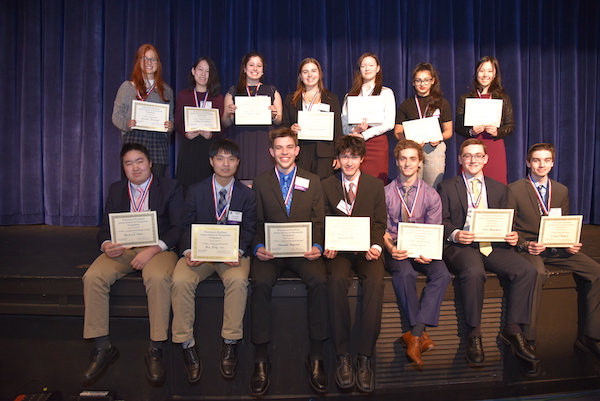
Facilities:
Stuary Mattey outlined some items affecting the facilities budget, which is expected to go up $364,525 or 4%. The increases are primarily due to:
The addition of air conditioning, which he anticipates will increase the district’s electric bill by $61,000 to power the units.
The Safety and Security Budget will rise by $244,570 to allow for improvements in the lock down system and the addition of gates and security film. The total budget for safety and security will be $1,363,871.
Environmental testing will continue with $65,000 in testing for lead in the water and another $34,500 to replace lead water filters.
Also in the budget for plant improvements for next year are:
-The installation of ceiling fans in elementary school gyms
-De-commission the science wing elevator at the high school which is out of service and no longer needed.
-Exterior painting at schools
-Repointing and bricks and roofing ($250,000)
-Building condition survey items as identified in the master plan ($185,000)
-Asbestos abatement $75,000
-Bus compound renovations - $60,000
High School Auditorium
Another big item of discussion was a proposed $2.3 million for renovation of the high school auditorium. This would be funded by a transfer to the capital fund. The auditorium has not been renovated for 40 years and is need of updating.
The administration proposes to:
-Remove and replace seating
-Remove and replace carpeting
-Repair concrete below seating
-Replace and improve sound system
-Replace and improve lighting control systems
-Replace and improve stage lights
-Improve stage rigging
-Replace and improve electric wiring
These improvements would bring the auditorium up to current standards and impact performances and the students who work with the equipment.
The auditorium renovation prompted some discussion from the Board. Chris Morin said, “The auditorium work is an awful lot in a year without a bond. Could this be done in two phases over two years? He later commented, “It is smaller than Greenacres but larger than many other projects.”
Stuart Mattey responded, “This list was put together after a lot of discussion with the stakeholders.” Dr. Hagerman said he met with PTC who “wanted an affirmation that this will be done.”
Scott Silberfien asked, “Can we set up a meeting and invite community input on the auditorium? I want to make sure we’re doing it right for all the stakeholders.”
Following some discussion, the Board agreed to keep the auditorium work in the budget for now and get community input. Dr Hagerman recommended that the Board partner with the SHS PTA to get feedback on the auditorium, saying, “this will help to enrich the dialogue.”
The Board will meet again on the budget on March 9, adopt a budget on April 20 and hold the community wide budget vote on May 19.
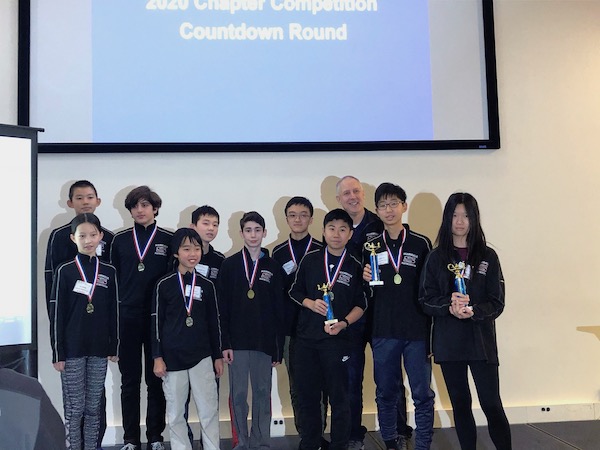 For the 10th year in a row, the Scarsdale Middle School Mathcounts team took first place at the Westchester/Putnam Mathcounts Competition. 18 schools were represented. Onto the state competition March 7. Iris Wang, Partick Chen, Alex Rizk, Frederick Li, Kenneth Ren, Tommy Kornfeld, Thomas Xin, Bryan Chung, Janghee Lee, Sophi Li and Coach Steve Weiss. Photo credit: Laura Ren.
For the 10th year in a row, the Scarsdale Middle School Mathcounts team took first place at the Westchester/Putnam Mathcounts Competition. 18 schools were represented. Onto the state competition March 7. Iris Wang, Partick Chen, Alex Rizk, Frederick Li, Kenneth Ren, Tommy Kornfeld, Thomas Xin, Bryan Chung, Janghee Lee, Sophi Li and Coach Steve Weiss. Photo credit: Laura Ren.
Mold
In other news, the Superintendent reported on a mold finding at the middle school in October, 2019. At the time, the district responded to a teacher complaining of a persistent cough who worked in room C57 which is on the lower level of the school.
Testing found elevated humidity in the room and a visual inspection showed moisture permeating the exterior wall of the room which is below grade and a leaking pipe. When the baseboard of the exterior wall was removed, mold was discovered on the lower few inches of the wall, “with the potential for mold to be present on the interior of the wall as well.”
The classroom is about two feet below grade and has a grass covered hill outside the windows. Peeling paint and plaster were found in the southwest corner of the room and the plaster was found to read “at risk” and “wet” on the moisture meter. It is suspected that water runoff from the sloped hill causes water intrusion. A few ceiling tiles were stained and a leaking pipe was discovered in the plenum.
Air samples showed elevated counts of Basidiospores and Aspergillus/Penicillium in room C57. Lead was detected at the low levels in the plaster wall paint. The concentration of fungi in the room was more than three times higher than found in a control room where no moisture was found. See the environmental testing results here:
Retirement
Victoria Presser from the Public Information Office of the schools announced that she will retire after 18 years in the district in June 2020.
Personnel
Haley Rauch was recommended for tenure in the math department at Scarsdale High School.
Joy Ying has approved as a replacement math teacher for Elise Nelson at Scarsdale High School.
Proposed 20-21 School Budget To Increase 3.77% Over 2019-20
- Details
- Written by: Laura Halligan
- Hits: 3088
 Last week, the school district announced that the proposed 2020-21 school budget would increase 3.86 percent over this year’s, resulting in a 3.6% percent increase to the tax levy. Since then, the administration made changes to health insurance cost projections, bringing the budget down a bit, but the plan still is a significant 3.77 percent over the current year budget, translating to a 3.51 percent tax levy increase.
Last week, the school district announced that the proposed 2020-21 school budget would increase 3.86 percent over this year’s, resulting in a 3.6% percent increase to the tax levy. Since then, the administration made changes to health insurance cost projections, bringing the budget down a bit, but the plan still is a significant 3.77 percent over the current year budget, translating to a 3.51 percent tax levy increase.
On Monday 2-5, district officials provided the first look at the nearly $167 million plan and the story behind the numbers.
Assistant Superintendent for Business Stuart Mattey began the session by reminding attendees about the district’s “guiding factors” in developing each year’s budget and offering a timeline of the process and list of public budget sessions between now and April. He then went on to speak about the district’s efforts to identify and capitalize on cost/spending efficiencies wherever possible.
“It’s always an additive process; we’re always coming back and asking for more, more, more, more. Sometimes that feels like the case but, behind the scenes, we do think of how we can do things better; how can we spend our money more efficiently; is there a different way of thinking about (something),” Mattey offered. He then pointed out a variety of the district’s budget efficiencies, including its self-funded health care plan, maximization of state aid, cooperative agreements with Scarsdale Village, purchasing practices, and technology advancements.
In looking ahead to next year’s plan, district managers asserted that the budget maintains Scarsdale’s high quality of teaching and learning and aligns with the district’s strategic plan goals. Specifically, it’s designed to:
• Ensure appropriate staffing levels;
• Enrich classroom school libraries;
• Provide materials/resources to support an “exemplary” math program, including piloting new math tools, technology, and resources to align the elementary math program with next generation standards;
• Improving global opportunities for students via travel, hosting, and virtual/online experiences;
• Provide and enhance STEAM experiences for all students;
• Create new garden models, biomechanical innovations, sustainability, and wellness projects;
• Expand the district’s ability to educate students with disabilities and those in need of specialized support; and
• Continue to upgrade building facilities consistent with the district’s master plan.
The Upshot
The draft budget currently stands at $166,850,850, which is just over $6 million more than last year’s. If adopted, Scarsdale residents would pay 3.35% more in taxes and those in the Mamaroneck Strip will pay 4.17% more. Mattey said, “It’s still a draft budget, but it’s getting closer and closer to where we need to be for the board to adopt it in April. The numbers are becoming more concrete.” He noted that the current tax levy figure is just under the projected tax levy limit of 3.54% (or $49,266).
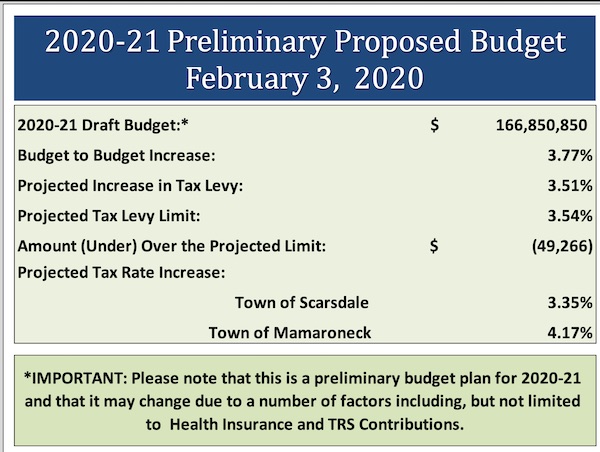
When addressing the levy, Mattey stated, “We think 2 percent (when thinking of the limit) but rarely would it be 2 percent. The allowable tax levy, before going over the cap, is made up of not only the CPI (which currently is 1.81 percent and capped at 2 percent)… but also can be driven up by a tax-base growth factor, which is based on property assessments. We get that from the state and that number went up 10 percent… that drives the levy limit up, and then there are capital exclusions. That number in transfer to capital… also drives the (limit).” Mattey also stressed the budget still is preliminary and will change based on pending information and discussion.
Budget Drivers
The plan provides for increased spending across a number of major areas, with the largest percentage increases in plant and capital improvements, transportation (including a transportation study to review issues such as routes, staffing, GPS use, and vehicles), employee compensation and benefits, operations and maintenance, and interscholastic athletics (due to increased coaching positions/stipends, Butler Field track/sound system, and athletic training expenses), among others.
The district proposes adding 3.4 full time employees in 2020-21, two of whom will support elementary special education efforts and are based on expected enrollment. As reported earlier, district staffing has increased from 610.55 employees in 2009-10 to a planned 630.1 next year.
As always, compensation and benefit costs are the largest component of the budget by far, accounting for well over $100 million. Personnel costs throughout the district continue to rise; contractual salary increases for all employees will total $3.07 million, teacher and New York State employees retirement system mandated contributions will increase $863,000; the district’s medical insurance expense is projected to increase 4.4 percent to $762,000; and other employee benefit increases will total $524,000.
Board Member Scott Silberfein addressed the benefit increases, saying, “Obviously we don’t have a say on employee benefits for the most part… this seems to be a little bit more than in years’ past… I would be interested in exploring whether or not either a transfer from the health insurance reserve or something else may make sense to smooth out the impact on taxpayers.” Mattey noted that the 4.4 percent increase was not out of the ordinary and that it would be a danger to fund recurring costs with reserves meant to cover extraordinary events. Silberfein agreed but noted that, “We should have that discussion… I think part of the ideas of reserves is to smooth out dips and valleys and mountains for taxpayers.”
Other major budget drivers are costs related to increasing special education enrollments and plant improvements/transfers to capital fund to support high-priority infrastructure projects and facility upgrades, including the high school auditorium. The auditorium renovation, which has been deferred from previous years, has generated a fair amount of interest due to an estimated total cost of $2.3 million, most of which will be covered via a funds transfer. BOE Member Christopher Morin said, “We have to talk more about what this is, what the scope of work is, and what we get out of it. It’s a big number.” Mattey is expected to provide more information on the project during his facilities presentation planned for next week.
The district expects to recoup some costs next year, including a $225,000 reduction in the tax certiorari budget as older claims settle, a $250,000 savings in debt service due to lower interest rates on upcoming loans, and a gain of $175,000 after a reversal of prior-year non-recurring expense for security-related computer purchases.
Cooling and Security Priorities
Mattey and Assistant Superintendent of Personnel and Administrative Services Drew Patrick also reviewed specific district initiatives developed in response to resident/parent feedback that will impact facilities spending. The first of these is the installation of cooling solutions for use on excessive heat days (90 degrees or higher on the heat index). Patrick reported, “We decided to look at being able to provide workable spaces for our students on high heat days through a three-phase process.” He explained, “The first phase was to try and gain some equity across our seven buildings in having enough cooling spaces during the day… for all students to continue their learning.”
The district already has installed window air conditioning units throughout six of the buildings, and split A/C units at Heathcote. It now is working on providing at least one air conditioned, large group common space in each building, and has installed rooftop units to cool the Quaker Ridge and Fox Meadow libraries. Over the long term, the district will review both traditional and alternative options to provide additional cooled spaces with an eye towards sustainability. This year’s proposed budget provides for the installation of ceiling fans in four elementary school gymnasiums (Quaker Ridge already is equipped with fans). The district also is exploring the possibility of adding fans to multipurpose rooms sometime in the future. Ceiling fans, unfortunately, are not a viable option for the middle school and high school auditoriums due to potential problems with sports activities, such as volleyball.
Mattey then discussed the district’s efforts to enhance school safety, security, and emergency management. The district’s approach is multi-pronged, with three main components: 1) providing an external layer of safety and security at all buildings by adding visitor management and safety personnel; 2) providing additional mental health and social/emotional support for students; and 3) continuing to implement policies, practices, and procedures to promote safety and security. Prior to the start of this school year, additional safety monitors were added, directly managing visitors to each building every day, and monitoring the building site during student hours. The district also hired two new staff members: a district-wide psychologist and a high school teacher dedicated to academic pre-referral support to help identify and address potential problems. In addition, every school has a building-level safety and emergency response team that trains on a regular basis to assure consistent best practices.
The next budget discussion session is this coming Monday, February 10, at 6:30 pm, and members of the public are invited to attend and comment. For more information on specific expenses and savings, as well as supporting information, see the complete preliminary budget document, which is posted on the district’s website.
2020-21 School Budget, Staffing and Technology Update at the School Board Meeting
- Details
- Written by: Joanne Wallenstein
- Hits: 4046
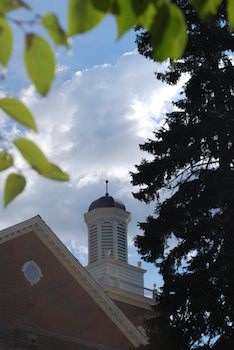 On the agenda for the Scarsdale Board of Education on Monday January 27, 2020 were the 2020-21 school budget, staffing and a report on the use of technology in the Scarsdale Schools. Here is what you need to know:
On the agenda for the Scarsdale Board of Education on Monday January 27, 2020 were the 2020-21 school budget, staffing and a report on the use of technology in the Scarsdale Schools. Here is what you need to know:
School Budget:
The current estimate for the 2020-21 school budget is $166,988,817 which is an increase of 3.86% over the 2019-20 school budget and translates to a 3.6% tax increase. The reasons for the increase will be discussed at a subsequent meeting.
Staffing:
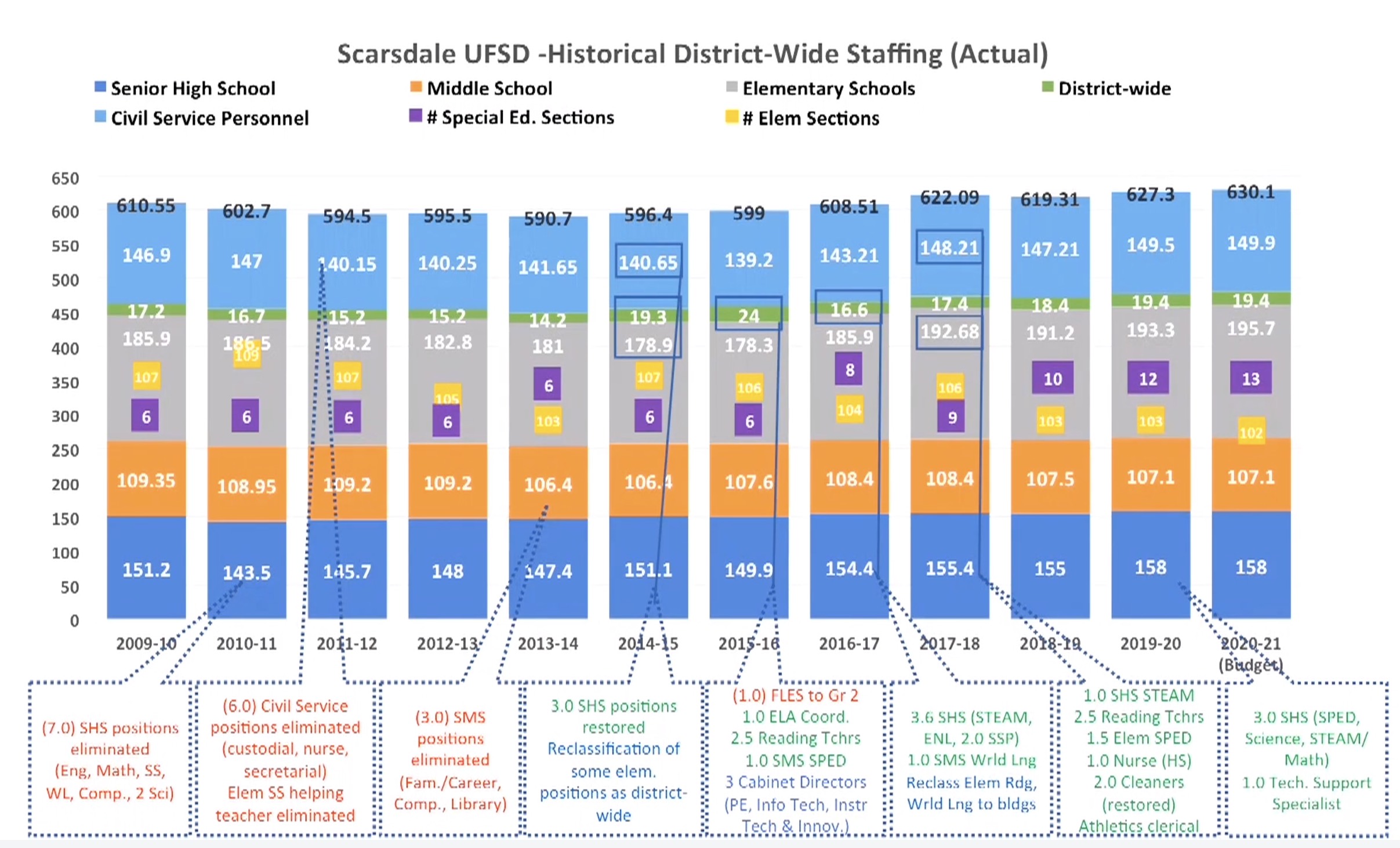
As a first step in the budgeting process, the Board reviewed district staffing. The graphic below shows that in the last ten years, district-wide staffing has increased from 610.55 employees to 630.1 projected for 2020-21.
The reasons for these staff increases was explained by Assistant Superintendent Drew Patrick.
-During this ten-year period, the number of special education elementary classes has risen from 6 sections, to a projected 13 for the next school year and special education staff was added at the middle school and high school to accommodate students in the upper grades.
-Over the years, five elementary reading teachers were added to support students at each of the five schools.
- At the high school, staffing was increased by three positions to accommodate the STEAM curriculum and opening of the new design lab at SHS.
After a discussion, the Board gave tentative approval, or a “soft nod,” for an additional 2.4 FTE’s for 2020-21 including:
One elementary special education co-teaching position
One elementary special education teacher for the new 8:1: 2 classroom that will accommodate some students who are now placed out of the district. The cost of this position should be offset by a reduction in out of district tuition payments.
A .4 FTE for the psychologist’s secretary at the middle school
Board member Scott Silberfein agreed that the additional staffing was needed but expressed concern about the proposed budget increase. He said, “We are now at a 3.86% budget to budget increase. I am concerned about the overall budget increase. I know it’s early and it may shift, but this is higher than we’ve seen over the last few years.”
Chris Morin concurred, saying, “Including security, it’s a 45 addition to head count over these last six years with flat enrollment, and that is just extraordinary. The 3.86% is an awful lot …. Sooner or later we will create a problem for ourselves if we don’t get our arms around that issue.”
Retirements and Tenure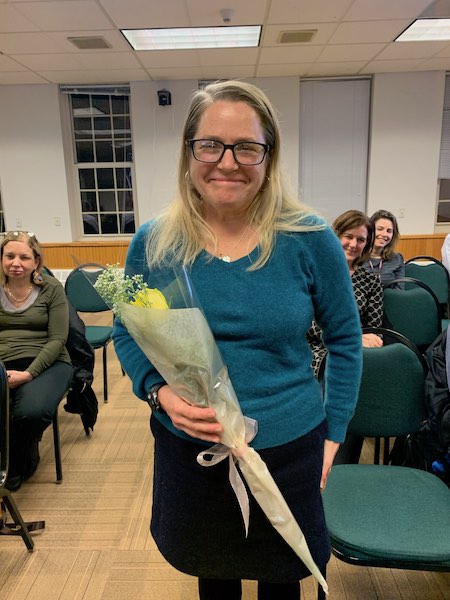 Phys Ed Teacher Maggie Bryant was granted tenure.
Phys Ed Teacher Maggie Bryant was granted tenure.
Drew Patrick announced the retirement of three teachers, together representing 99 years of teaching.
They are:
Heidi Kaplan – Math teacher at Scarsdale Middle School
Renee Lund – Special Education from Scarsdale Middle School
Tom Maguire – Social Studies teacher at Scarsdale High School
Tenure was granted to SHS Physical Education teacher Maggie Bryant who was present with her family for the announcement.
Technology and STEAM Update
Director of Technology Jerry Crisci and SHS Steam Coordinator Lisa Yokana provided an impressive report on the integration of technology into all district schools. Updates on the STEAM curriculum at Scarsdale High School, now in its fourth year and information on the district’s Center for Innovation, now in its eighth year were provided.
Crisci explained that the overall goals of his department are outlined in “The Scarsdale Technology Vision Statement.” It calls for the district to “use technology to empower learners” by giving them tools for creating, communicating and collaborating.”
He explained how various activities at all grade levels address goals such as teaching students to be good digital citizens, creating computational thinkers, innovative designers and creative communicators.
At each school, students learn to navigate age appropriate databases and sources. Common experiences across the elementary schools includes
-Digital citizenship at all ages
-Publishing projects
-Coding robotics
-Google apps in grades 3-5
-Fifth grade capstone project
Computer teachers engage in professional development to learn how to teach these skills.
At the middle schools, seventh grade students are using iPads, as well as old fashioned pen and paper. The middle school library offers more advanced databases and use of resources as well as Schoology, a learning management platform for school homework and assignments.
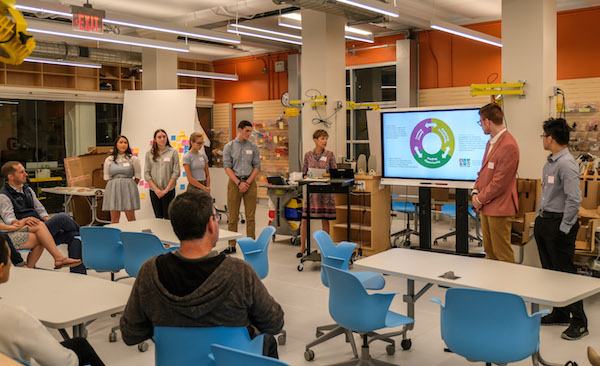 The Design Lab at Scarsdale High SchoolAt the high school Chromebook carts are available in English, social studies and world language classes. Desktop computers are available in the computer lab and the district’s most powerful computers are available in the digital media labs.
The Design Lab at Scarsdale High SchoolAt the high school Chromebook carts are available in English, social studies and world language classes. Desktop computers are available in the computer lab and the district’s most powerful computers are available in the digital media labs.
Students can bring their own devices and often mediate between the use of different kinds of technology, paper and books. The high school library includes sophisticated databases for use by the students.
Turning to the STEAM Program, Crisci said that it begins in sixth grade and extends through the tech classes in grades 6,7 and 8. The curriculum focuses on design, computational thinking, pre-engineering and problem solving.
SHS Teacher Lisa Okana reviewed the high school STEAM program, saying, “We want to create students that are curious, empathic and empowered. Our first level courses are an intro to engineering and design. The second level courses include robotics, electronics/physical computing, design for modern production, design build and app design. At the third level the program offers advanced topics entrepreneurship. This full year course focuses on designing for students with disabilities and is a college level class.”
She explained, that students are both experts and teachers, for example a student teaches other students in app development. Members of the community often serve as consultants. Students learn to collaborate, share ideas, co-work to solve challenges. The program encourages students to share their knowledge. In this course, students create prototypes and put them in the hands of users.
According to Yokana, “The assessment process includes a great deal of process notes, and reflection. They pitch their ideas and get feedback.” Yokana explained, that the design thinking process includes the following:
-Creating prototypes
-Testing assumptions
-Learning through experimentation
-Learning resilience
-Designing real things that can make a difference
-Becoming empowered as agents of change.
The program is successful and has become a model for many other schools that regularly visit Scarsdale. Recently one of the class design teams won a $5,000 grant from Wells Fargo Bank for creating functional clothing for children who cannot dress themselves.
The Center for Innovation (CFI)
The Scarsdale Center for Innovation is now eight years old. It originally started with speakers, site visits and project grants. The Center offered teachers CFI grants and has had seven years of impacts, resulting in the creation of maker spaces at all the elementary schools, a music maker program, Level Up Village at the middle school and an engineer in residence.
Other initiatives included the creation of The Nest, a space for innovation at the middle school, and the awarding of a grant for the creation of an applied math class at the high school.
District personnel have used CFI funds for site visits to NuVu in Cambridge, MA, to the MIT media lab and the Hynes Institute at Iona College.
In February 2019, the district launched a program called CFI Ambassadors, where 21 teachers were named to become influencers both inside and outside the district. Their mission is to:
-Change long term behaviors and mind sets
-Change many people and many interlocked behaviors
-Change minds, hearts and actions
Each ambassador has been asked to identify an opportunity for innovation and using skills to effect change.
Following the technology discussion, the Superintendent gave an update to the strategic plan.
Watch the entire meeting online here: https://vimeopro.com/scarsdaleschoolstv/boe-2019-2020
- Willy Wonka, Jr. On Stage at Edgewood Elementary School
- New Board Leadership for a New Year -- Plus Budget Numbers, Enrollment Projections and Proposed 20-21 Calendar
- Girls Basketball Still Trying To Find Its Rhythm
- Sports News: Four Honored at Section 1 Football Awards Dinner, Hockey Team Donates Gifts for Kids










